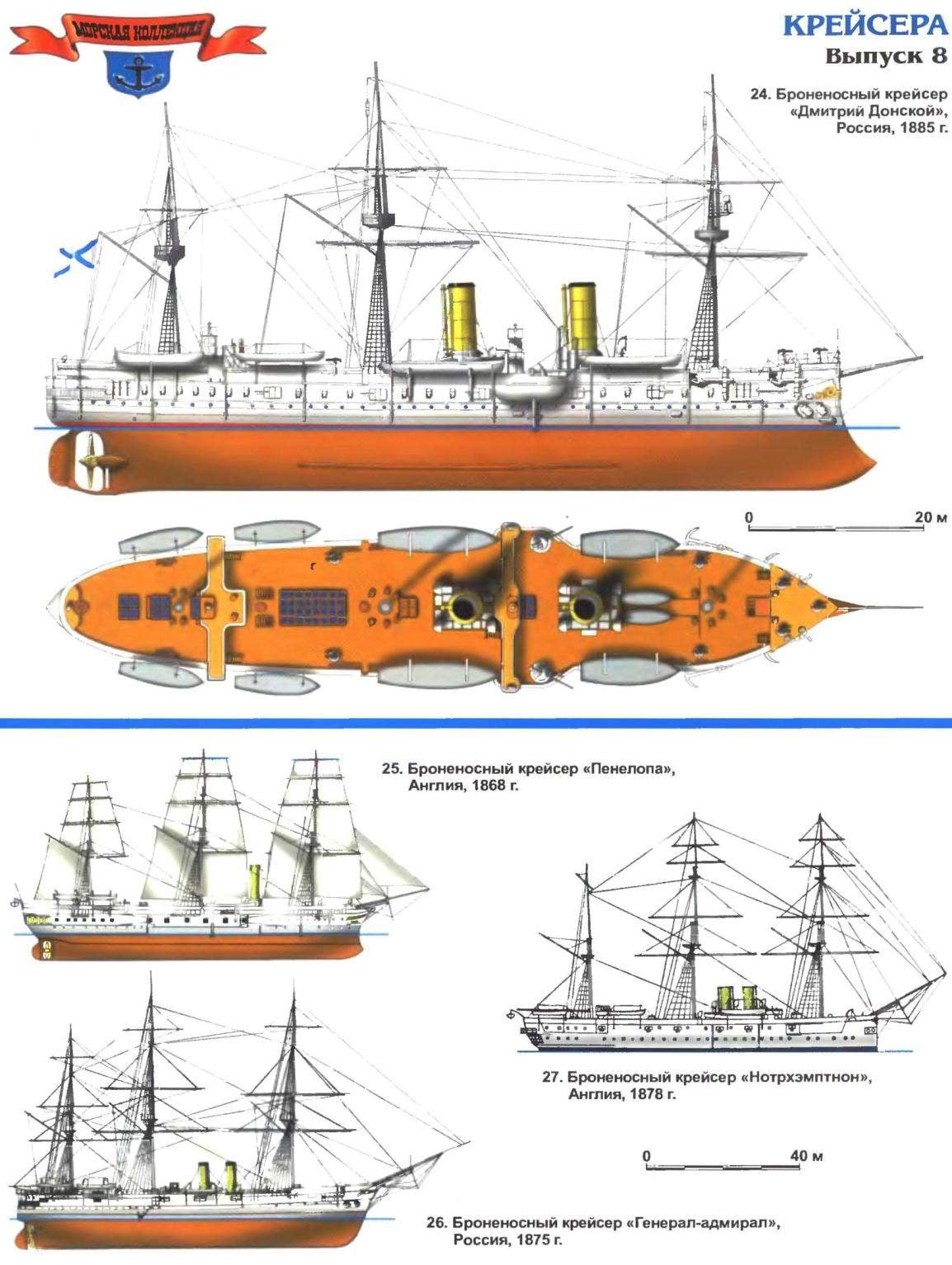 the First British battleship “warrior” with his appearance in 1861 changed naval “table of ranks” in the most radical way. He and other armored frigates suddenly swept from the stage as the wooden ships of the line, and although armed with powerful artillery, but unprotected counterparts. Typical of the cruiser, in fact, become the new battleships. It is not surprising that the designers soon had the idea to do the same operation with units of smaller size.
the First British battleship “warrior” with his appearance in 1861 changed naval “table of ranks” in the most radical way. He and other armored frigates suddenly swept from the stage as the wooden ships of the line, and although armed with powerful artillery, but unprotected counterparts. Typical of the cruiser, in fact, become the new battleships. It is not surprising that the designers soon had the idea to do the same operation with units of smaller size.
In the armored fleets of England and France, all warships that had iron belt at the waterline, at that time was called the armadillos — just in case. For example, along with desyatitysyachnye “Warrior”, “Achilles”, “Minotaur”, “Agincourt” and “Northumberland” in the main forces of the Royal Navy and was listed as such “pocket” ships, like 1350-1750 enterprise and ton-ton “research”. DAV cruisers to call them was incorrect: neither speed (9-10 knots), no range and seaworthiness they are not suited for corporate life. A certain confusion in the minds of the admirals and engineers has led to the fact that the British had to invent for them a rather strange class of ships — armored sloops.
A little more in line with the cruising specifications armored corvettes. The first of these, 3250-ton “Feyvorit”, which entered into operation in 1866, remained discoparty, and its armament consisted of eight smoothbore (!) 100-fotovac. Loser has served only 10 years before sending in a reserve, where he stood as much again before you go to be scrapped. Had a Central battery, “Pallas” (3660 t, 1866), at first glance, is quite consistent with raider performance, with a speed of over 13 knots and rifled 178-mm artillery. However, in fact, built on the personal initiative of a famous shipbuilder of E. reed, the ship had been originally a specialized RAM. In fact, the only real cruiser from the early Rangoni battleships were only “Penelope”. This Corvette with a narrow armor belt and armored Central battery had a high Board and good seakeeping. However, the location of artillery did not contribute to the solution of cruising task: battery vosmidesyati could not shoot the bow and stern, which operated only three 127-graph paper, which are generally removed in the course of modernization in 1878. Even from this brief description it is evident that the British were not so very wrong in not assigning a proud cruising the title of his little armoured vessels.
The French, like the British, too, preferred in doubtful cases, call their armored cruisers battleships. The first such polylaser, “Belies”, formed two years after the commissioning of the “Warrior”, but it was a weak wooden ship with a displacement of 3700 tons, which had a full armor belt at the waterline with a thickness of 150 mm and a battery with a 120-mm armor, which housed four 194 mm and 164 mm rifled breech-loading guns. Two more 164-mm guns were on the upper deck and was the primary weapon in bad weather and in the end, because the battery ports were rising above the water only 2 m and are often filled with waves. Two years later this was followed by a great solo for France a series of 7 units of the “Alma.” Originally intended to impose on them a very progressive scheme of location of the artillery: four 164-mm guns on the corners of the Central battery. Already during the construction of the scheme was changed to an even more advanced, replacing General casemate on four separate barbecue installation. But after a more thorough calculation of weights the designers have begun to doubt the possibility of reduction of stability and left only two Barbet; four guns the old fashioned way placed in battery.
And “Belies” and “Alma” with the company received another type of weapon that have become a hallmark of French cruisers. Issued by three meters forward, the wooden battering RAM was covered with several layers of metal and represented quite a serious threat. Alas, to see this had not the enemy. In July of 1877 “Tethys” successfully rammed its sister ship “Rhine Blanche”. Fortunately, both ships were rescued.
In 1868 the French quite consistently repeated the previous series, increasing the displacement of up to 4600 t, that though as-that to eliminate the main drawback of their “cruisers” — to increase the maximum speed, which barely exceeded 11 knots. Three “La Galissoniere”, “Tiompan” and “Victories” developed in the service of about 12.7 site. Another improvement was the larger caliber guns: “galissoniere” carrying six 240-mm guns instead of 164-mm (at the same location — two in barbettes and four in the battery), plus one 194 mm linear gun and six 138-millimetrovogo on the upper deck.
Further improvement in the same direction— increase in speed — showed the next pair, “Bayar” and “Turenne”. For its time (and was put into operation, they are only in 1882) housing material (all the same tree) was already quite archaic, as opposed to the location of artillery. All four 240 mm guns of the model 1870 was placed in the barbettes, and two of them for the first time on cruisers were located in the median plane: one in the middle of the body and the other in the stern, and another two side by side closer to your nose. The armament was supplemented by a pair of 194 mm (linear and recordnum) and six 138-mm guns. Also for the first time a French cruise ship appeared 50-mm armor deck covering on top of the armor belt, the thickness of which reached in the middle of the case is 250 mm. Speed increased to 14.5 knots, but increased the displacement, which reached 6000 tons. In General, the French armored cruiser gradually returned to business failure, in the ranks of ironclads, and did not become real raiders or “destroyers of the raiders.” “Pathetic nephew of the great uncle” of Napoleon III, there was neither the desire nor the doctrines for war at sea. And the collapse of 1871 left the broken Empire in severe economic and political problems.
Oddly enough, but neither Britain nor France in the 1860-ies did not even try to create a full armored cruiser. And the idea of such a ship appeared in Russia. Father armored cruiser fleet can rightly be called Admiral A. A. Popov. He had a rich experience of long hikes and a good understanding of how valuable it may be in time of war a strong ocean ship, able if necessary to fight with any of the many frigates or corvettes of the enemy and to get out of this fight, retaining the ability to further raiding. And this is highly desirable to have the full armor belt, covering the waterline. In 1868, A. A. Popov presented the project of a radical remaking of the wooden frigate “General-Admiral”, which was supposed to leave only six guns, but large caliber, to replace the entire lower part of the body on the iron with the steel armor. However, the frigate was so amazed at the decay that chose to build a new ship.

24. Armored cruiser “Dmitry Donskoy”, Russia, 1885
Built at the shipyard of the New Admiralty in St. Petersburg. Displacement 5800 t waterline Length 90,43 m, width of 15.85 m draft 7.85 m Power single-shaft steam installation of 7,000 HP, speed 16 knots Reservations: belt 152— 120mm (armor “compound”), 51 mm deck. Armament: two 203 mm, fourteen 152 mm and the four 87-mm guns, 14 small-caliber turret guns, five 381-mm torpedo tubes. In 1895, upgraded with the installation of new rapid-fire artillery, six 152-mm, ten 120-mm, six 47-mm and ten 37-mm guns. Only in 1884— 1885 built 2 units somewhat different construction and armament: “Dmitry Donskoy” and “Vladimir Monomakh”. Both died in the battle of Tsushima on may 28 1905
25. Armored cruiser “Penelope”, England, 1868
Built at the shipyard of the Navy at Pembroke. 4470 T. displacement waterline Length 83,2 m, width 15,24 m, draft 5,15 m Capacity single-shaft steam setting 4760 HP., speed 12.75 mm uz. Reservations: belt 152 mm, 152 mm battery Armament: eight 203-mm and five 127-mm muzzle-loading rifled guns. In 1897, retired from the Navy and turned into a floating prison in South Africa. Scrapped in 1912
26. Armored cruiser “General-Admiral”, Russia, 1875
was Built on Nevsky plant in St. Petersburg. Displacement 5030 t waterline Length 87,12 m, width of 14,63 m and draft of 7.37 m. the Capacity of a single-shaft steam setting 4470 HP, speed of 12.3 KTS. Reservations: belt 152— 127 mm Armament: six 203-mm and two 152-mm and four 87-mm guns. Later added eight 37 mm revolving guns and two 381-mm torpedo tubes. Only in 1875 — 1877 built 2 units: “General-Admiral” and “Duke of Edinburgh”. In the 80-ies of the XIX century. both rearmed, in 1892 and 1896, respectively, received new engines and boilers. Served as training ships until 1909, then converted into mine layers “Narva” and “Onega”.
27. Armored cruiser “Northampton”, Britain, 1878
Built by “Napier”. 7630 T. Displacement waterline Length of 88.1 m, a width of 18.29 m, a Deposit of 7.58 m. Capacity twin-shaft steam installation 6100 HP, the speed of 13.25 bonds. Reservations: belt 229— 152 mm, deck 51 mm. Armament: four 254-mm and eight 229-mm rifled guns, six 20-pounder smoothbore guns. Only in 1878— 1881 he built 2 units: “Northampton” and “Nelson.”In the 90-ies of the XIX century, both modernized and rearmed, but soon both sent to the reserve. “Northampton” scrapped in 1905 and Nelson in 1910.
Since the main task expected of an individual RAID, special attention was drawn to the speed, seaworthiness and autonomy. Application raketnogo for reduced body weight up to 30% (the first iron “British” “Inconstant”, this figure reached 50%). Hence there was a possibility to allocate more than 400 tons on the reservation. The caliber of the guns limited the 203 mm because it was believed that the auxiliary cruisers (which in large quantities could muster in case of war, England) can’t carry anything heavier than a 6-Dujmovic. Due to the fact that the number of guns was limited to only four trunks to maximize the angle of attack they mounted on the protruding overboard semicircular platforms called sponsons. Now of the 8-Dujmovic could fire almost at the bow and stern, do not fear for the integrity of all as rich rigging. New “General-Admiral” still carried almost 2.5 thousand square meters of sails other ways to provide greater duration of the voyage in those days did not exist.
Successful experience decided the fate of another ship, the “languishing” nearly 10 years on the same Nevsky shipyard. Founded in 1865, the “Pearl” (similar to sailing steam battleship “Knyaz Pozharsky”) had to undergo a lot of changes, many of which, fortunately, remained only on paper. During the construction of the Technical Committee of the Russian Navy Department proposed to turn it into a fashionable tower battleship. However, death in a storm Descoberto prototype of the British “Captain” — was forced to suspend all work. Only in 1874 A. A. Popov insisted on another remake, this time in ocean cruiser on the model already released for testing “General Admiral”. The builders had to work the entire surface part of the side was dismantled and made the new project, the underwater part is sheathed with wood and copper, removing the pre-armor belt, which was established again in 1878, just before the commissioning.
The British regarded the Russian ocean armored raiders without any enthusiasm. Their appearance meant a great threat to the “mistress of the seas”. Therefore, the Admiralty ordered to oppose a couple of “General-Admiral” — “Duke of Edinburgh” (the second ship of the series, ironically, was so exotic for our fleet name in honor of the visit of the British Prince) of their own, only more powerful. So appear true Royal Navy armored cruiser “Nelson” and “Northampton”. Noticeably larger, they were carrying more powerful weapons and slightly exceeded the speed of their opponents. Their project largely based on the first full British armored cruiser “Shannon”, founded in 1873, almost simultaneously with the “General-Admiral”. This vysokovoltny three-masted ship had a thicker armored belt (229 — 152 mm), deck and even the cabin (229 mm). The British themselves say that “the reason for its appearance in the fleet is somewhat obscure”. However, the original purpose of its founders is quite clear: Britain is needed in combat units intended for service in remote corners of the vast Empire, strong enough to crush a weak battleships of possible opponents, and quick enough to chase after them and other enemy vessels. Although the “Shannon” had a reputation negovorite ship, the artillery of two 254-mm and seven 229-mm rifled muzzle-loading guns (normal for the British in those days) looked convincing enough. In fact, he could compete with the “General-Admiral” or “Minin” with a very good chance to win.
However, Russia did not stop there. In 1880, the same indefatigable A. A. Popov presented the draft of the improved ships of the vending class. Although the “Dmitry Donskoy” and “Vladimir Monomakh” was inferior to “the Nelsons” in displacement, but for purely cruising qualities of speed and range of speed left rivals far behind. Booking for the first time carried out storagelink plates “compound”, the resistance of which exceeded the iron a quarter. Our admirals preferred to have more guns, though somewhat smaller caliber, rightly believing that a lone raider is more important to suppress a weaker opponent and try to get away from stronger. In the course of construction on both ships managed to introduce all sorts of innovations, but to each their own. So, “Monomah” received a two-shaft machinery installation, and “don” is closed at the top with the battery. First cruiser equipped with regular propellers instead of lifting. As a result, they have become almost purely steam fighting ships: if the course of sailing the screws provided significant resistance — and the speed has remained small.
“Monomah” was built in a record for the period over 20 months. This time the British not tried to create a symmetrical response. But this does not mean that the “enlightened sailors” paid Russian threat any attention. On the contrary: when “Monomakh” was released in its first foreign journey to the far East, all the way he was constantly accompanied by one of the newest British battleships. In 1884-1885 years of relations between the two countries remained very tense, and potential opponents often went with loaded guns and artillery open ports.
At that time there was no bloodshed. However, the best Russian armored cruisers had a long career. Most of their service was in the Pacific waters near the dangerous neighbor — quickly build muscles Japan. There and ended their career. Doing once familiar route Kronstadt — the far East, this time in the 2-nd Pacific squadron ZP Rozhdestvensky, they became members unlucky for us the battle of Tsushima. “Vladimir Monomakh” received a torpedo hit and was sunk the next morning. But the share of “don” fell heavy, but a nice lot. After the fight, the main force who served at that time about 20 years Russian cruiser managed to fight off six opponents — light and auxiliary cruisers, although got a lot of hits. Unlike their armored counterparts, such as “Svetlana” or “Novik”, “Donskoy” managed to keep the speed and buoyancy, quite convincingly proving the validity of the doctrine of the raider with a fully armored waterline. Hot From battle he went undefeated and only because of the complete hopelessness of the situation was flooded by the team the next morning. The last battle “the don”, absolutely unfairly forgotten and is rarely mentioned by historians, belong to the most brilliant pages of Russian naval glory.
V. KOFMAN



